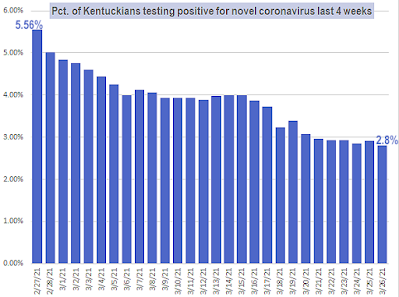
Kentucky Health News graph; click on it to enlarge.
—–
By Al Cross
Kentucky Health News
Every measure of the pandemic in Kentucky declined Friday, except death, and even that lagging indicator’s averages kept declining, not counting deaths being found by an ongoing audit.
The percentage of Kentuckians testing positive for the novel coronavirus fell again, to 2.8%, about half of what it was a month ago (or four weeks, since last month was February).
The state reported 646 new virus cases, lowering the 7-day rolling average by 12, to 602, the lowest since Sept. 12.
The statewide rate of new cases over the last seven days fell to 11.38 per 100,000 residents. Counties with rates more than double the statewide rate were Lyon, 53.9; Simpson, 53.1; Owsley, 45.3; Whitley, 29.5; Powell, 27.7; Knox, 27.5; Lee, 25.1; and Mercer, 24.8.
Counties with 10 or more new cases were Jefferson, 110; Fayette, 52; Warren, 30; Scott, 24; Adair, 19; Madison, 16; Boone, 15; Clark, 13; Barren, Daviess, Mercer and Oldham, 12; Kenton, McCreary and Whitley, 11; and McCracken and Wayne, 10.
Kentucky hospitals reported 383 Covid-19 patients, 20 fewer than Thursday; 88 were in intensive care and 46 of those were on ventilators, down 18 and 3, respectively. Only the Lake Cumberland hospital region, at 82%, reported more than 80% of its intensive-care beds in use, and just 16% had Covid-19 patients.
The pandemic’s death toll in Kentucky passed 6,000, as state officials added 27 more deaths to their official list of Covid-19 victims, plus 11 found by an ongoing audit of death certificates. That pushed the death toll to 6,008.
Unlike Thursday, there was no overlap in the two reports’ dates of deaths. The dates of the regularly reported deaths ranged from Jan. 11 to March 24. The deaths found by audit were Dec. 8-27.
Not counting the deaths found by audit, the state’s daily death average has been on a slow, general decline for the past month. Based on dates the deaths were officially listed after review, the 14-day rolling average declined from 25.2 on Feb. 27 to 21.1 on Friday.
Gov. Andy Beshear did not comment on any daily numbers or averages in his press release, but continued to emphasize vaccination.
“More than one in three Kentucky adults have been vaccinated so far, which is a huge milestone,” he said. “If you haven’t been vaccinated, see where you can sign up. If you’ve got a family member or friend who wants their shot of hope, help them get registered and call our vaccine hotline, 855-598-2246 or TTY 855-326-4654 (for deaf or hard-of-hearing Kentuckians), if you need help. Together, we can defeat Covid-19 this year, but we have to keep up our momentum.”
A survey in Jefferson County found that 91% of residents would choose vaccination, with slightly lower rates among minorities.
“About 3% of white and 8% of minority participants indicated they would never choose vaccination,” said a
news release from the
University of Louisville Christina Lee Brown Envirome Institute. “Minority participants reported they were more likely to choose vaccination with celebrity endorsement, offerings by faith organizations and vaccination requirements. White participants were more likely to choose vaccination if their family and friends or elected officials were vaccinated and with evidence of efficacy.”
The survey was conducted as part of the
Co-Immunity Project to understand the impact of Covid-19 in Jefferson County. Most of the 1,296 people who responded online to the mailed invitation were over 60 or over (44%), female (61%) and white (84%), and 90.2% reported being unvaccinated.
The state Department of Education updated its guidance on school distancing to match that of the Centers for Disease Control and Prevention: three feet, if all students are masked. Six feet is still required in common areas and during activities such as singing, band and sports, which should be moved outside.
In other pandemic news Friday:
- The state Corrections Department reported 196 active cases among prisoners, 171 at the state penitentiary; 12 employees at the prison were among the 19 staffers with active cases.
- “Outside of big cities, where office buildings remain vacant, people in America are becoming more active,” The Washington Post reports after its analysis of cell-phone data showed that in parts of the Deep South and Mountain West, mobility is higher than it was before the pandemic. “This spring fever is palpable across much of the country,” the Post reports, “and as people are on the move so is the virus: There is increasing evidence of a new bump in cases.”
- Women are more likely than men to have gone without health care during the pandemic, and as a result women who had health and economic challenges beforehand have had worse health conditions, according to a survey by the Kaiser Family Foundation, which concluded, “These gaps in care could translate into higher numbers of women experiencing severe health issues after the health emergency from the pandemic resolves.”
- Kaiser also reported, “The pandemic has had a significant effect on people’s mental health, with 51% of women and 34% of men saying that worry or stress related to the pandemic has affected their mental health. Most say that the impact has been moderate or minor, but almost one-fifth (21% women, 17% men) say the toll has taken a major impact on their mental health.”
